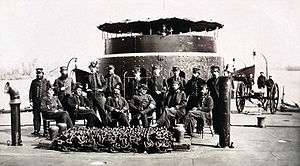USS Sangamon (1862)
USS Sangamon was a Passaic-class ironclad monitor constructed for the Union Navy during the second year of the American Civil War where she operated in the waterways of the Confederate States of America. She was later recommissioned and placed into service during the Spanish–American War.
 USS Jason at New York during the Spanish–American War. | |
| History | |
|---|---|
| Name: | USS Sangamon |
| Builder: | Reaney, Son & Archbold |
| Laid down: | 1862 |
| Launched: | September 9, 1862 |
| Commissioned: | February 9, 1863 |
| Decommissioned: | ca. 1865 |
| Recommissioned: | May 13, 1898 |
| Decommissioned: | 1899 |
| Renamed: | USS Jason, 10 June 1869 |
| Fate: | Sold April 1904 |
| General characteristics | |
| Class and type: | Passaic-class ironclad monitor |
| Displacement: | 1,335 long tons (1,356 t) |
| Length: | 200 ft (61 m) o/a |
| Beam: | 46 ft (14 m) |
| Draft: | 10 ft 6 in (3.20 m) |
| Installed power: | 320 ihp (240 kW) |
| Propulsion: |
|
| Speed: | 7 kn (8.1 mph; 13 km/h) |
| Complement: | 77 |
| Armament: | 1 × 15 in (380 mm) smoothbore gun, 1 × 11 in (280 mm) Dahlgren gun |
| Armor: |
|
| Notes: | Armor is iron. |
Construction
The first U.S. Navy ship to be so named, Sangamon was built by the shipbuilding firm Reaney, Son & Archbold under the name Conestoga in the summer of 1862; renamed Sangamon on September 9, 1862; launched on October 27, 1862; and commissioned on February 9, 1863 at Chester, Pennsylvania, Commodore Pierce Crosby in command.
Assigned to the North Atlantic blockade
The monitor was assigned to the North Atlantic Blockading Squadron and soon began efficient but unspectacular operations in Hampton Roads, Virginia and in the many roughly parallel rivers which empty into Chesapeake Bay. Sangamon was one of the vital ships of the Navy which guaranteed the Army control of the waters which border and penetrate the bitterly contested land which separated Washington, D.C. and Richmond, Virginia.
After repairs at Philadelphia, Pennsylvania on 21 February 1864, she was towed by Wachusett to Port Royal, South Carolina for duty with the South Atlantic Blockading Squadron. After Union blockade duty off Charleston, South Carolina, she returned to Hampton Roads in the summer to support General Ulysses S. Grant's drive on Richmond, Virginia.
Varied river duties
Sangamon performed widely varied duties. She conducted reconnaissance expeditions up the river to obtain information, and often dueled Confederate forces hidden along the banks. She guarded Union troop concentrations and served as part of the Union naval force which patrolled the upper James to prevent the Confederate flotilla from threatening Union transports.

In March–April 1865, during the final thrust on Richmond, Virginia, she assisted in clearing the river of Confederate torpedoes (mines) and countering the threat of Confederate ironclads so that Union shipping could proceed safely to the Confederate capital. One of her final wartime assignments Sangamon was required to perform, was to accompany the tugboat flotilla towing the previously captured and unfinished Confederate casemate ironclad CSS Texas (1865) to her final destination at the Norfolk Naval Shipyard on May 3, 1865. The overall expedition was led by Sangamon's skipper at the time, Lieutenant Commander R. Chandler.[1]
Post–Civil War operations
After the war ended, Sangamon was decommissioned at Philadelphia and placed in reserve. Renamed Jason on 10 June 1869, no record has been found of any subsequent active service until she was recommissioned on 13 May 1898 for service during the Spanish–American War. The old monitor was stationed at Fisher's Island, Long Island, New York where she provided the New York City area with some degree of naval protection against the perceived threat of a raid by Spanish cruisers.
Final decommissioning
In 1899, she returned to Philadelphia and was placed in reserve at League Island, where she remained until sold in April 1904.
Sources
- This article contains text from the US Naval Historical Center.
- This article incorporates text from the public domain Dictionary of American Naval Fighting Ships. The entry can be found here.
- Additional technical data from Gardiner, Robert (1979). Conway's All the World's Fighting Ships 1860–1905. Conway Maritime Press. p. 120. ISBN 0-85177-133-5.
References
- Official Records of the Union and Confederate Navies in the War of the Rebellion, Series I, Vol. 12, p. 98, 1901